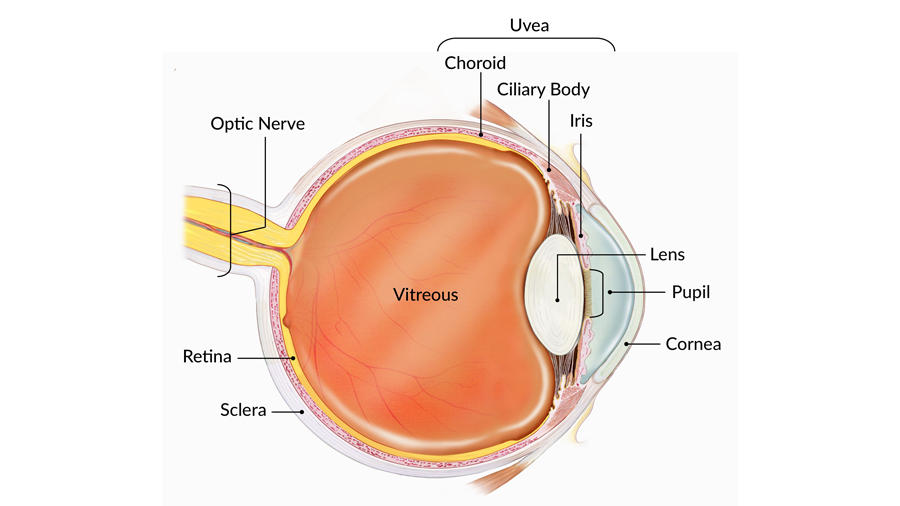The gift of sight
The National Eye Institute declared May to be Healthy Vision Month to inspire members of the public to take good care of their eyes and to raise awareness of programs designed to ensure that people of all ages get access to eye care.
The human eye is an evolutionary phenomenon, one of aesthetic beauty and profound function. Each of your two beauties contains approximately 130 million specialized cells. The fastest muscle in the human body is contained in the eye, which blinks more than 10,000 times a day (and each blink happens in less than 1/100th of a second). Our eyes can also differentiate about 10 million different colors, with the capacity to see an ant crawl across the picnic table and a star light up the night sky.
More than 285 million people are living with some degree of visual impairment. Yet about 80% of vision problems worldwide can be avoided or cured. What are some of the more common eye diseases, and what are some steps that you can take now to take care of your peepers?
Retinopathy
For those of you who live with diabetes like me, the word "retinopathy" ("disease of the retina") is all too unfamiliar. With more than 400 million people living worldwide with diabetes, diabetic retinopathy has far-reaching consequences.
Lining the back two-thirds of your eye, the retina is the nerve layer responsible for receiving images. It senses the light allowed into your eye and sends electrical impulses to the optic nerve, communicating with the brain for interpretation.
There are several kinds of retinopathy, however all are related to vascular damage of the small blood vessels that can impair vision. While normal blood vessels on the retina are typically smooth, any damage to them can cause bleeding. The buildup of damaged vessels and even fatty formations can alter visual acuity.
Diabetic retinopathy is the most common form. Early diabetic retinopathy is characterized as nonproliferative. At this stage, new blood vessels aren't growing, but patients may have retina weakening and retain fluids in the retina. Advanced diabetic retinopathy is known as proliferative, and at that more severe stage abnormal blood vessel growth does happen, resulting ultimately in scarring, sometimes retinal detachment, nerve damage and glaucoma.
Hypertensive-related retinopathy exists as well. This affects people with severe and prolonged high blood pressure.
Macular degeneration
The macula is located near the center of the retina, and it is the part of the eye responsible for our central vision.
Age-related macular degeneration is the most common cause of vision loss for older adults. The condition makes it challenging to see signs at a distance, drive or read. Occurring slowly in most people, dry macular degeneration is caused by a thinning of the macula. The faster wet form occurs when there is abnormal vasculature growth that damage the macula.
Glaucoma
A very important component of the eye is the optic nerve. Millions of fibers carry visual messages from the retina to the brain, which can process and correctly identify images that are observed for only 13 milliseconds! Although there are several types of glaucoma, the most common is open-angle glaucoma. This primarily affects people over the age of 50 and causes loss of peripheral vision.
Glaucoma does rarely occur in infants and children, and in those cases it's usually caused by an underlying condition. According to the American Association for Pediatric Opthalmology and Strabismus, about 10% of congenital glaucoma cases are inherited.
Healthy choices to protect our eyes
When we think of eyesight, we may not be able to relate this singular sensory organ to the rest of our mammalian system. Despite this, eyesight is key not only for vision but also for balance and our circadian rhythm. Although some conditions can directly affect our vision (i.e. hypertension, diabetes), we can actively take steps to protect this important sense. The National Eye Institute has compiled a list of steps and preventative measures here.
Eyes on the prize
Below are summaries of recent eye-related articles published in the American Society for Biochemistry and Molecular Biology's three open-access journals.
Visual cycle defects in the eye: Researchers at the University of California, Irvine, review the biochemical regeneration of chromophore pigments associated with our rods and cones. They take a look at two distinct mechanisms for this process and relate the current pharmacological and genomic therapies in use to bypass the dysregulation of these steps. Read their Journal of Biological Chemistry article.
Fueling our vision: A team of experts from Massachusetts, California and Sweden writes in the Journal of Lipid Research about the energy demands of the photoreceptors that help us to see, including what is known of the fuel sources and metabolic processes used. They detail the balance between different fat types and other energy sources on photoreceptor metabolism and what is known about dyslipidemia in retinal disorders.
Biomarkers for glaucoma: In the journal Molecular & Cellular Proteomics, researchers in China discuss their study characterizing the proteome of 175 patients with various forms of glaucoma to unravel common features and evaluate upregulation of proteins key to distinguishing glaucoma from cataract. Their work aims to better understand the mechanisms of glaucoma and identify potentially novel treatments.
More eye research news

A study of old flies offers new insight into retinal degeneration: Researchers discovered the circadian clock plays a significant role in protecting eyes from retinal degeneration. The team studied fruit flies, which serve as a good model for the human retina.
There's more to cholesterol than meets the eye: When it comes to a role in glaucoma, it’s all about location, location, location.
Fatty retina: Abnormalities of lipid metabolism are common in diabetes, so the authors of this article reasoned that the retina might switch its programming in response to an abundance of fuel.
Vision health depends on critical fat intake: To understand better how dietary omega-3 supplementation can modify the content of fatty acids in the retina, researchers investigated how lipids and lipid metabolism intervene in the function and dysfunction of the retina.
A change in labs reveals a key to cataract formation: Researchers studying lens crystallin proteins describe how two types of damage interact.
Enjoy reading ASBMB Today?
Become a member to receive the print edition four times a year and the digital edition monthly.
Learn moreGet the latest from ASBMB Today
Enter your email address, and we’ll send you a weekly email with recent articles, interviews and more.
Latest in Science
Science highlights or most popular articles

Fueling healthier aging, connecting metabolism stress and time
Biochemist Melanie McReynolds investigates how metabolism and stress shape the aging process. Her research on NAD+, a molecule central to cellular energy, reveals how maintaining its balance could promote healthier, longer lives.

Mapping proteins, one side chain at a time
Roland Dunbrack Jr. will receive the ASBMB DeLano Award for Computational Biosciences at the ASBMB Annual Meeting, March 7–10, just outside of Washington, D.C.

Exploring the link between lipids and longevity
Meng Wang will present her work on metabolism and aging at the ASBMB Annual Meeting, March 7-10, just outside of Washington, D.C.

Defining a ‘crucial gatekeeper’ of lipid metabolism
George Carman receives the Herbert Tabor Research Award at the ASBMB Annual Meeting, March 7–10, just outside of Washington, D.C.

The science of staying strong
Muscles power every movement, but they also tell the story of aging itself. Scientists are uncovering how strength fades, why some species resist it and what lifestyle and molecular clues could help preserve muscle health for life.

Bacteriophage protein could make queso fresco safer
Researchers characterized the structure and function of PlyP100, a bacteriophage protein that shows promise as a food-safe antimicrobial for preventing Listeria monocytogenes growth in fresh cheeses.


